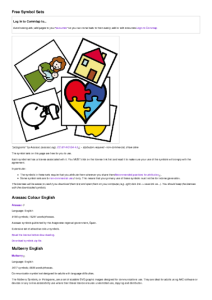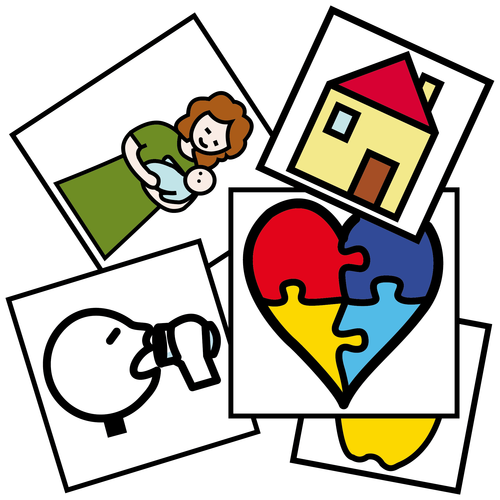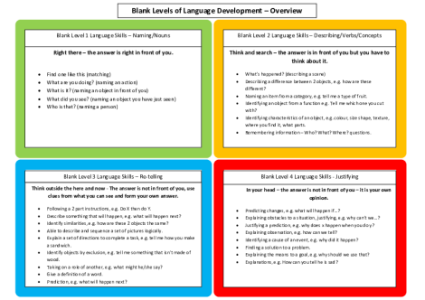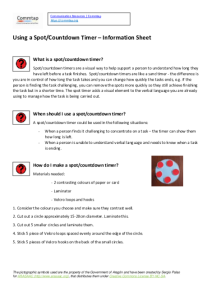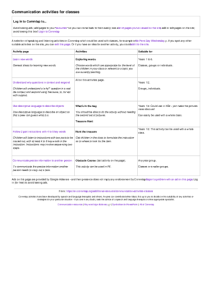Search
User login
Topic “Other understanding”
Using visual timetables
Ideas for using visual timetables.
Visual timetables are an easy and powerful way to help children to stay engaged with lessons and to support their understanding of what's going on and what they need to do.
Research evidence shows that this type of support can reduce anxiety and confusion whilst supporting a child's memory for what they need to do in tasks.
Example visual timetables
You can use a visual timetable to map out the whole day:
Be familiar with written words
| Activity/strategy name and materials required | How to do the activity | Key principles for doing the activity and comments |
|---|---|---|
| Word labels in any lesson/situation
|
| The goal is simply for the child to become familiar with the written words and begin to link them to language. You are not expecting them to use the words in any way - though if they do point at word, confirm what they have pointed to - and respond appropriately. Refer to the written words naturally during talking. Make sure you refer to the written word often. Don't "test" the child - e.g. don't say "point to the word for this". You can facilitate errorless communication - for example "which one shall we put in next" - with a choice of words to choose from: then go with the child's response and include the word in your spoken response to them. |
Strategies to support attention, listening and understanding language in students aged 7+
Created 2 November 2021.
Information sheet - using a spot/countdown timer
Created 13 July 2021; updated 24 October 2021.
sequences three pictures showing a practical activity
| Activity/strategy name and materials required | How to do the activity | Key principles for doing the activity and comments |
|---|---|---|
| Practical sequences Camera to make the picture sequences (or alternatively you can draw them or use a commercial resource). Resources as appropriate to carry out a simple sequence Examples of sequences (with suggested steps to make pictures for): Putting on a jumper (get jumper, put head through, put arms through); Drinking a drink (jug and cup, pour water into the cup, drink it) Peeling and eating a piece of fruit (fruit, peel fruit, eat it) Sitting down and eating dinner Drawing a picture (pencil and paper, child drawing, finished picture) Looking at a book (get it, open it, look at it) | 1. Carry out the activity without the pictures; 2. Do it again, showing the relevant picture for each part of the activity as you do it; 3. Get the child to do the sequence, tell them what to do by showing them a picture for each part of the sequence; 4. Get them to show you what to do by giving you a picture for each part of the sequence. Try to do exactly as the picture you are given indicates, for example if they give you a picture of someone blowing bubbles without having given you the step for opening the bubbles container, try to blow the bubbles anyway (and act being disappointed when you don't get any bubbles). | At this level children may often be able to learn particular sequences of pictures without understanding that they relate to a sequence of actions, these activities are designed to address this issue. Seeing how the sequence goes wrong if the wrong picture is chosen (in step 4) will encourage the child to work out which should have been the right picture without you needing to give any further feedback. |
think and talk about events in the past and future
| Activity/strategy name and materials required | How to do the activity | Key principles for doing the activity and comments |
|---|---|---|
| Which day? Sheet of paper with 3 boxes drawn on them for yesterday, today and tomorrow. A counter. Optional: sets of symbol cards or pictures showing a variety of activities - including activities the student may have done. You can create symbols cards using the Commtap Symboliser for PowerPoint. | 1. Talk about each day, one at a time. Get the student to draw or write things they have done or will do in each box. Use the picture symbols if the student is having difficulty coming up with things. 2. When you have finished, explain that there is going to be a quiz. Describe an activity and the student must say if they did it yesterday, did it today or will do it tomorrow. 3. Have them step the counter over onto the right day. | This works best when there are key things which are different about each day! |
| The Story of Fred Set of three pictures - one showing a picture of a child, one showing a picture (preferably of the same person!) at a similar age to the student and one a picture of an older person. These could be photographs or drawings. Choose three ages which are appropriate/relevant for the student.
Large 'thought clouds ' on A3 or A4 paper: Sticky tape Pens Picture symbol prompts if required. You can create symbol prompts using the Commtap Symboliser for PowerPoint. | ||
| Calendar Calendar Pens | This is an ongoing activity. You could take photos of the key events, and put them on the calendar. | |
| Daily Schedule/Picture Schedule Any activity or set of activities where the student might use a schedule or have a visual timetable. You can create a visual timetable/schedule using the Commtap Symboliser for PowerPoint. |
Share information about self with others
| Activity/strategy name and materials required | How to do the activity | Key principles for doing the activity and comments |
|---|---|---|
| Likes and dislikes Optional - something to record the students responses on (e.g. paper/pen) which can later be used as a prompt; Soft ball or beanbag. |
| To make it harder, you can go around again asking for favourite drinks - so that everyone now has to remember a food and a drink for each student when they pass the ball (e.g "Tim - you like carrot cake and tea"). You could use favourite games, favourite places to go, etc. instead. |
Talk about things in the recent past
| Activity/strategy name and materials required | How to do the activity | Key principles for doing the activity and comments |
|---|---|---|
| What have you done today? Optional - way of recording students responses - e.g. paper/pen, whiteboard/marker |
| Variations
|
| What have you done today - with a ball Optional - way of recording students responses - e.g. paper/pen, whiteboard/marker Soft ball or beanbag |
Communication activities for classes
Created 12 September 2012; updated 11 May 2023.
Communication activities for classes
A selection of speaking and listening activities on Commtap which could be used with classes, for example on No Pens Day Wednesday. If you spot any other suitable activities on the site, you can edit this page. Or if you have an idea for another activity, you could add it to the site.
Learn new words
| Activity/strategy name and materials required | How to do the activity | Key principles for doing the activity and comments |
|---|---|---|
| Exploring words Written word with a picture Written sounds for beginning/ end of each word Visuals for the story Dictionary (maybe)
| Ideas you can use to help word learning - you do not need to use all of them, and some will work better than others for different children. 1. Introduce the written form of the word; 2. Say the word to the child and ask for repetition; 3. Ask the child to clap syllables on your or their hands, use prompting if necessary. Or alternatively they could tap the syllables out on pictures of drums (say four arranged in a row); 4. Ask if any other words rhyme with this new word (think of examples yourself) - you could take this in turns in a group; 5. Ask for beginning and ending sounds; 6. Tell the child a short story or anecdote, including the word as the main feature if possible - or work with the child to work a story out; 7. Give an explicit definition (school dictionary maybe - some dictionaries are more helpful than others for this!) and give context(s) preferably first one being the one used in the story as it’s familiar but make sure to offer other contexts; 8. Ask the child if they can put the word in a sentence/ tell a short story including the word; 9. If ability allows, ask the child if they know of any word which means a similar thing. | These activities help to build a child’s vocabulary with solid representations of words. It gives a child strategies to use when learning and remembering new words. It builds the child’s confidence on a topic, especially if taught before the relevant lesson. |
Support Commtap to keep it online
Thank you for visiting Commtap.
Please read this message as it is extremely important.
- Visitor donations mean we can continue to host over 1,000 free activities to support speech, language, and communication development.
- Visitor donations mean we can continue to provide free resources to address a wide range of communication needs, including limited speech or language, interaction challenges, and needs associated with conditions such as developmental language disorder, autism, and cerebral palsy.
- Visitor donations mean we can continue to provide resources to support the work of speech and language therapists, teachers, teaching assistants, parents, and carers.
- Visitor donations mean we can continue to provide the free key word sign dictionary (bks.org.uk) which has over 2,000 Makaton and Signalong signs.
We know that not everyone is able to afford to pay to access these resources, however, if you can, please make a donation to keep the site going.
Thank you
Google ads on this page are provided by Google Adsense - and their presence does not imply any endorsement by Commtap. Report a problem with an ad on this page. Log in (for free) to avoid seeing Google ads.
